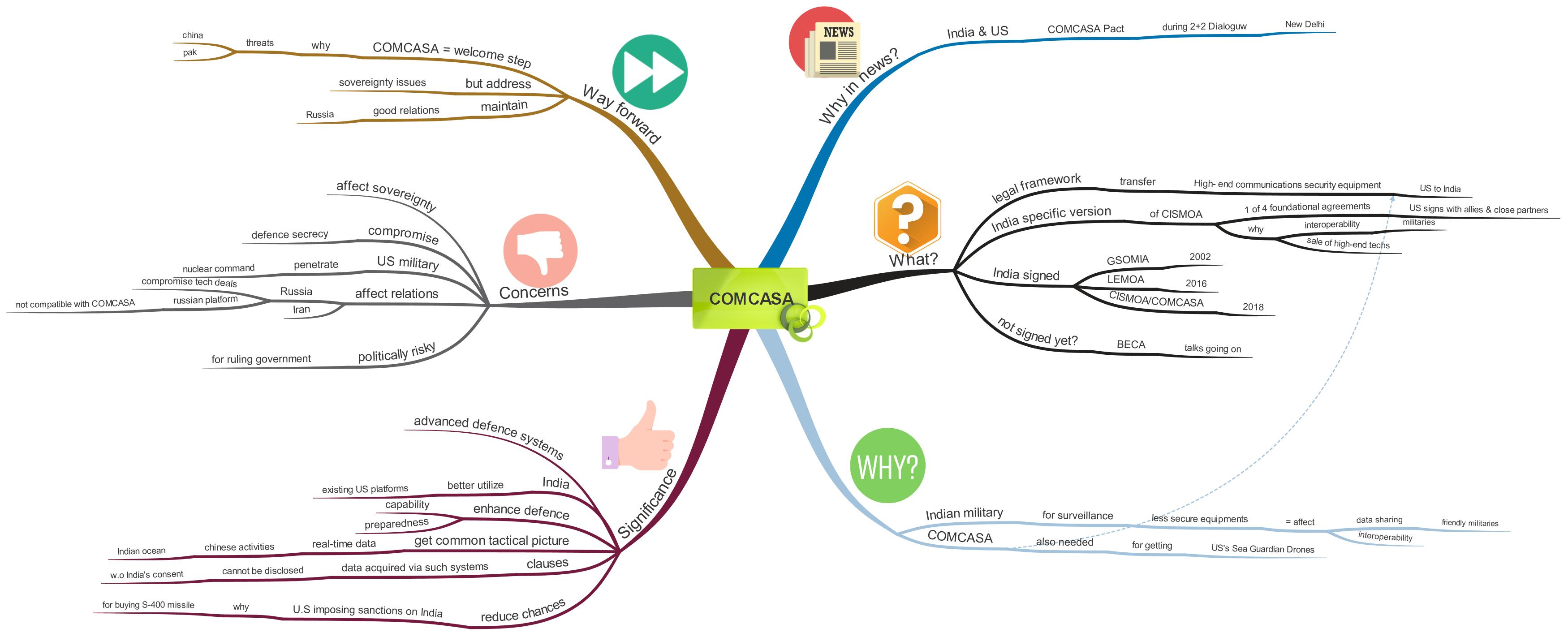COMCASA – The Pact that will Enhance India’s Defence Capability

From Current Affairs Notes for UPSC » Editorials & In-depths » This topic
IAS EXPRESS Vs UPSC Prelims 2024: 85+ questions reflected
India and U.S. on September 6, 2018, signed the agreement on Communications Compatibility and Security Agreement (COMCASA) on the sidelines of the 2+2 dialogue which was held in New Delhi.
What is COMCASA?
- COMCASA is meant to provide a legal framework for the transfer of communication security equipment from the U.S. to India.
- It is the India specific version of CISMOA (Communication and Information on Security Memorandum of Agreement).
- CISMOA is one of the four foundational agreements that the U.S. signs with allies and close partners in order to facilitate interoperability between militaries and sale of high-end technology.
- Among the 4 agreements, India signed GSOMIA (General Security of Military Information Agreement) in 2002, LEMOA (Logistics Exchange Memorandum of Agreement) in 2016 and CISMOA/COMCASA in 2018. The last one remaining is the BECA (Basic Exchange and Cooperation Agreement for Geo-spatial Cooperation).
Why COMCASA?
- Indian armed forces are currently dependent on less secure, commercially available communication systems for surveillance.
- This affects real-time data sharing with friendly militaries and seamless interoperability during joint missions.
- Thus COMCOSA will enable Indian military to use high-end secured communication equipment from the U.S.
- Furthermore, COMCASA is crucial if India is to get the armed version of the Sea Guardian drones from the U.S.
You might want to read: India’s Nuclear Doctrine – Is it necessary to revisit?
Significance of COMCASA
- COMCASA would facilitate access to advanced defense systems and enable India to better utilize its existing U.S Origin platforms.
- The pact will enhance India’s defense capability and preparedness.
- It will enable greater communications interoperability between the militaries of India and the U.S.
- It will facilitate India to access secured US communications equipment which seamlessly links ground, air, surface and subsurface assets for getting a common tactical picture. This equipment, for instance, could allow India to obtain real-time data on the presence of Chinese warships submarines and aircraft in the Indian Ocean.
- Clauses are available in COMCASA which specifies that the data acquired through such systems cannot be disclosed or transferred to any person or entity without India’s consent.
- COMCASA could also reduce the chances of the U.S. imposing sanctions on India for looking to buy Russian S-400 surface-to-air missile systems.
Concerns about COMCASA
- COMCASA may harm India with respect to its military decisions and policy and in turn, affect its sovereignty.
- Although it has provisions for not disclosing the information without India’s consent, there is still concern about granting the U.S. access to Indian military communication system and in result compromise India’s defense secrecy.
- US military may penetrate India’s strategic areas like the nuclear command.
- It would hamper India’s geopolitical and strategic relations with other countries such as Russia and Iran.
- It may compromise our high technology deals with Russia such as SU-30MKI combat aircraft.
- A lot of Russian-origin and indigenous Indian military communication platform may not be compatible with COMCASA.
- These kind of complicated arrangement are politically risky for the ruling government as even the previous LEMOA (signed in 2016) created a political ruckus in the country.
What is the way forward?
Signing the COMCASA with the U.S. is a welcome step considering the growing threats of China and Pakistan in the region. However, the government should also address the concerns about the sovereignty issues and maintain good relations with its long-term friend Russia for better prospects in the long term.
If you like this post, please share your feedback in the comments section below so that we will upload more posts like this.


